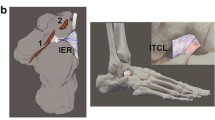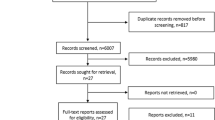Abstract
Purpose
To give a systematic overview of current diagnostic imaging options and surgical treatment for chronic subtalar joint instability.
Methods
A systematic literature search across the following sources was performed: PubMed, ScienceDirect, and SpringerLink. Twenty-three imaging studies and 19 outcome studies were included. The Quality Assessment of Diagnostic Accuracy Studies 2 (QUADAS 2) tool was used to assess the methodologic quality of the imaging articles, while the modified Coleman Score was used to assess the methodologic quality of the outcome studies.
Results
Conventional radiographs were most frequently used to assess chronic subtalar joint instability. Talar tilt, anterior talar translation, and subtalar tilt were the three most commonly used measurement methods. Surgery often included calcaneofibular ligament reconstruction.
Conclusion
Current imaging options do not reliably predict subtalar joint instability. Distinction between chronic lateral ankle instability and subtalar joint instability remains challenging. Recognition of subtalar joint instability as an identifiable and treatable cause of ankle pain requires vigilant clinical investigation.
Level of evidence
Systematic Review of Level III and Level IV Studies, Level IV.




Similar content being viewed by others
References
Brunner R, Gaechter A (1991) Repair of fibular ligaments: comparison of reconstructive techniques using plantaris and peroneal tendons. Foot Ankle 11(6):359–367
Burks RT, Morgan J (1994) Anatomy of the lateral ankle ligaments. Am J Sports Med 22(1):72–77
Choisne J, Hoch MC, Alexander I, Ringleb SI (2017) Effect of direct ligament repair and tenodesis reconstruction on simulated subtalar joint instability. Foot Ankle Int 38(3):324–330
Coleman BD, Khan KM, Maffulli N, Cook JL, Wark JD (2000) Studies of surgical outcome after patellar tendinopathy: clinical significance of methodological deficiencies and guidelines for future studies. Victorian Institute of Sport Tendon Study Group. Scand J Med Sci Sports 10(1):2–11
Coughlin MJ, Schenck RC Jr, Grebing BR, Treme G (2004) Comprehensive reconstruction of the lateral ankle for chronic instability using a free gracilis graft. Foot Ankle Int 25(4):231–241
Crim JR, Beals TC, Nickisch F, Schannen A, Saltzman CL (2011) Deltoid ligament abnormalities in chronic lateral ankle instability. Foot Ankle Int 32(9):873–878
Dierckman BD, Ferkel RD (2015) Anatomic reconstruction with a semitendinosus allograft for chronic lateral ankle instability. Am J Sports Med 43(8):1941–1950
Harper MC (1991) The lateral ligamentous support of the subtalar joint. Foot Ankle 11(6):354–358
Harper MC (1992) Stress radiographs in the diagnosis of lateral instability of the ankle and hindfoot. Foot Ankle 13(8):435–438
Heilman AE, Braly WG, Bishop JO, Noble PC, Tullos HS (1990) An anatomic study of subtalar instability. Foot Ankle 10(4):224–228
Hintermann B, Knupp M, Barg A (2012) Peritalar instability. Foot Ankle Int 33(5):450–454
Ishii T, Miyagawa S, Fukubayashi T, Hayashi K (1996) Subtalar stress radiography using forced dorsiflexion and supination. J Bone Jt Surg Br 78(1):56–60
Jung HG, Kim TH, Park JY, Bae EJ (2012) Anatomic reconstruction of the anterior talofibular and calcaneofibular ligaments using a semitendinosus tendon allograft and interference screws. Knee Surg Sports Traumatol Arthrosc 20(8):1432–1437
Jung HG, Park JT, Shin MH, Lee SH, Eom JS, Lee DO (2015) Outcome of subtalar instability reconstruction using the semitendinosus allograft tendon and biotenodesis screws. Knee Surg Sports Traumatol Arthrosc 23(8):2376–2383
Karlsson J, Eriksson BI, Renstrom P (1998) Subtalar instability of the foot. A review and results after surgical treatment. Scand J Med Sci Sports 8(4):191–197
Kato T (1995) The diagnosis and treatment of instability of the subtalar joint. J Bone Jt Surg Br 77(3):400–406
Kerkhoffs GM, van den Bekerom M, Elders LA, van Beek PA, Hullegie WA, Bloemers GM et al (2012) Diagnosis, treatment and prevention of ankle sprains: an evidence-based clinical guideline. Br J Sports Med 46(12):854–860
Kim TH, Moon SG, Jung HG, Kim NR (2017) Subtalar instability: imaging features of subtalar ligaments on 3D isotropic ankle MRI. BMC Musculoskelet Disord 18(1):475
Larsen E (1988) Tendon transfer for lateral ankle and subtalar joint instability. Acta Orthop Scand 59(2):168–172
Lee BH, Choi KH, Seo DY, Choi SM, Kim GL (2016) Diagnostic validity of alternative manual stress radiographic technique detecting subtalar instability with concomitant ankle instability. Knee Surg Sports Traumatol Arthrosc 24(4):1029–1039
Lee KM, Chung CY, Kwon SS, Chung MK, Won SH, Lee SY et al (2013) Relationship between stress ankle radiographs and injured ligaments on MRI. Skelet Radiol 42(11):1537–1542
Li X, Killie H, Guerrero P, Busconi BD (2009) Anatomical reconstruction for chronic lateral ankle instability in the high-demand athlete: functional outcomes after the modified Brostrom repair using suture anchors. Am J Sports Med 37(3):488–494
Liu SH, Jacobson KE (1995) A new operation for chronic lateral ankle instability. J Bone Jt Surg Br 77(1):55–59
Louwerens JW, Ginai AZ, van Linge B, Snijders CJ (1995) Stress radiography of the talocrural and subtalar joints. Foot Ankle Int 16(3):148–155
Mabit C, Tourne Y, Besse JL, Bonnel F, Toullec E, Giraud F et al (2010) Chronic lateral ankle instability surgical repairs: the long term prospective. Orthop Traumatol Surg Res 96(4):417–423
Meyer JM, Garcia J, Hoffmeyer P, Fritschy D (1988) The subtalar sprain. A roentgenographic study. Clin Orthop Relat Res (226):169–173
Mittlmeier T, Rammelt S (2018) Update on subtalar joint instability. Foot Ankle Clin 23(3):397–413
Okuda R, Kinoshita M, Morikawa J, Jotoku T, Abe M (1999) Reconstruction for chronic lateral ankle instability using the palmaris longus tendon: is reconstruction of the calcaneofibular ligament necessary? Foot Ankle Int 20(11):714–720
Park HJ, Cha SD, Kim SS, Rho MH, Kwag HJ, Park NH et al (2012) Accuracy of MRI findings in chronic lateral ankle ligament injury: comparison with surgical findings. Clin Radiol 67(4):313–318
Park HJ, Lee SY, Park NH, Kim E, Chung EC, Kook SH et al (2015) Usefulness of the oblique coronal plane in ankle MRI of the calcaneofibular ligament. Clin Radiol 70(4):416–423
Pellegrini MJ, Glisson RR, Wurm M, Ousema PH, Romash MM, Nunley JA 2nd, et al (2016) Systematic quantification of stabilizing effects of subtalar joint soft-tissue constraints in a novel cadaveric model. J Bone Jt Surg Am 98(10):842–848
Pisani G (1996) Chronic laxity of the subtalar joint. Orthopedics 19(5):431–437
Ringleb SI, Dhakal A, Anderson CD, Bawab S, Paranjape R (2011) Effects of lateral ligament sectioning on the stability of the ankle and subtalar joint. J Orthop Res 29(10):1459–1464
Ringleb SI, Udupa JK, Siegler S, Imhauser CW, Hirsch BE, Liu J et al (2005) The effect of ankle ligament damage and surgical reconstructions on the mechanics of the ankle and subtalar joints revealed by three-dimensional stress MRI. J Orthop Res 23(4):743–749
Sammarco GJ, Idusuyi OB (1999) Reconstruction of the lateral ankle ligaments using a split peroneus brevis tendon graft. Foot Ankle Int 20(2):97–103
Schon LC, Clanton TO, Baxter DE (1991) Reconstruction for subtalar instability: a review. Foot Ankle 11(5):319–325
Sijbrandij ES, van Gils AP, van Hellemondt FJ, Louwerens JW, de Lange EE (2001) Assessing the subtalar joint: the Broden view revisited. Foot Ankle Int 22(4):329–334
Solheim LF, Denstad TF, Roaas A (1980) Chronic lateral instability of the ankle. A method of reconstruction using the Achilles tendon. Acta Orthop Scand 51(1):193–196
Sugimoto K, Samoto N, Takaoka T, Takakura Y, Tamai S (1998) Subtalar arthrography in acute injuries of the calcaneofibular ligament. J Bone Jt Surg Br 80(5):785–790
Sugimoto K, Takakura Y, Kumai T, Iwai M, Tanaka Y (2002) Reconstruction of the lateral ankle ligaments with bone-patellar tendon graft in patients with chronic ankle instability: a preliminary report. Am J Sports Med 30(3):340–346
Sugimoto K, Takakura Y, Samoto N, Nakayama S, Tanaka Y (2002) Subtalar arthrography in recurrent instability of the ankle. Clin Orthop Relat Res (394):169–176
Takao M, Oae K, Uchio Y, Ochi M, Yamamoto H (2005) Anatomical reconstruction of the lateral ligaments of the ankle with a gracilis autograft: a new technique using an interference fit anchoring system. Am J Sports Med 33(6):814–823
Thermann H, Zwipp H, Tscherne H (1997) Treatment algorithm of chronic ankle and subtalar instability. Foot Ankle Int 18(3):163–169
Tourne Y, Besse JL, Mabit C, Sofcot (2010) Chronic ankle instability. Which tests to assess the lesions? Which therapeutic options? Orthop Traumatol Surg Res 96(4):433–446
Tourne Y, Mabit C, Moroney PJ, Chaussard C, Saragaglia D (2012) Long-term follow-up of lateral reconstruction with extensor retinaculum flap for chronic ankle instability. Foot Ankle Int 33(12):1079–1086
van Hellemondt FJ, Louwerens JW, Sijbrandij ES, van Gils AP (1997) Stress radiography and stress examination of the talocrural and subtalar joint on helical computed tomography. Foot Ankle Int 18(8):482–488
Waldecker U, Blatter G (2001) Sonographic measurement of instability of the subtalar joint. Foot Ankle Int 22(1):42–46
Wang W, Xu GH (2017) Allograft tendon reconstruction of the anterior talofibular ligament and calcaneofibular Ligament in the treatment of chronic ankle instability. BMC Musculoskelet Disord 18(1):150
Weindel S, Schmidt R, Rammelt S, Claes L, v Campe A, Rein S (2010) Subtalar instability: a biomechanical cadaver study. Arch Orthop Trauma Surg 130(3):313–319
Whiting PF, Rutjes AW, Westwood ME, Mallett S, Deeks JJ, Reitsma JB et al (2011) QUADAS-2: a revised tool for the quality assessment of diagnostic accuracy studies. Ann Intern Med 155(8):529–536
Yamamoto H, Yagishita K, Ogiuchi T, Sakai H, Shinomiya K, Muneta T (1998) Subtalar instability following lateral ligament injuries of the ankle. Injury 29(4):265–268
Yoon DY, Moon SG, Jung HG, Kim NR (2018) Differences between subtalar instability and lateral ankle instability focusing on subtalar ligaments based on three dimensional isotropic magnetic resonance imaging. J Comput Assist Tomogr 42(4):566–573
Funding
Nicola Krähenbühl is currently receiving a grant from the Swiss National Science Foundation (SNF; grant number P2BSP3_174979) and Swiss Orthopaedics.
Author information
Authors and Affiliations
Contributions
NK: literature search, data extraction, and manuscript writing. MWW: literature search, data extraction, and manuscript writing. NPD: drawing of figures and manuscript writing. MKM: providing clinical cases (X-rays/MRI) and manuscript writing. BH: manuscript writing. CLS: manuscript writing. AB: literature search, data extraction, and manuscript writing.
Corresponding author
Ethics declarations
Conflict of interest
Maxwell W. Weinberg, Nathan P. Davidson, Megan K. Mills, Beat Hintermann, Charles L. Saltzman, and Alexej Barg have no conflicts to declare.
Ethical approval
This article does not contain any studies with human participants or animal experiments performed by any of the authrors.
Rights and permissions
About this article
Cite this article
Krähenbühl, N., Weinberg, M.W., Davidson, N.P. et al. Currently used imaging options cannot accurately predict subtalar joint instability. Knee Surg Sports Traumatol Arthrosc 27, 2818–2830 (2019). https://doi.org/10.1007/s00167-018-5232-8
Received:
Accepted:
Published:
Issue Date:
DOI: https://doi.org/10.1007/s00167-018-5232-8




